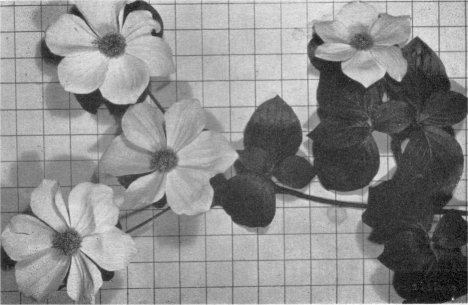
[click to enlarge]
Foliage and flowers of dogwood (Inch squares on background)
| Online Library: | Title | Author | California | Geology | History | Indians | Muir | Mountaineering | Nature | Management |
Yosemite > Library > Broadleaved Trees > Pacific Dogwood >
Next: California Buckeye • Contents • Previous: Rocky Mountain Maple
Cornus nuttalli Audubon — Dogwood Family (Cornaceoe)
This is one of the most attractive of Yosemite trees. Its beauty in the spring, when it is characterized by great numbers of large, showy, cream-white blossoms, vies with its attractiveness in the fall. At the latter season it is outstanding because of the brilliance of its crimson foliage and clusters of shiny red seeds. It has long been a highlight of interest in Yosemite National Park at those times, and many people make special trips to this area on such occasions primarily to enjoy the colorful spring and fall dogwood display.
Although it is occasionally found as high as 7,000 feet it is most generally noted at lower elevations. It is partial to moist, well-drained soils of mountain slopes and protected locations in valley bottoms. One will note it in abundance along the Wawona Road, and along the Big Oak Flat Road, as well as in many sections of Yosemite Valley. In the latter place it can be most readily found about Happy Isles, in the vicinity of Fern Springs, and about the Pohono Bridge.
The Pacific dogwood is not a large tree. Mature specimens attain a height of from twenty to fifty feet and a diameter of from ten to twenty inches. The trunk is generally straight and characterized by smooth, thin, dull gray bark. The crown is narrow and is composed of short branches. As it is intolerant of dense shade the crown, when the tree is growing in the dense forest, is short while the trunk is long and clear.

[click to enlarge] |
| Photo by Brockman |
|
Foliage and flowers of dogwood (Inch squares on background) |
The leaves are borne opposite upon the branches. They are from three to five inches long with the midvein and its branches conspicuously impressed upon the upper side. Numerous small, greenish-white flowers are borne in button-like clusters which are about one and one-half inches in diameter. These are surrounded by four to six showy, cream-white scales or bracts, often improperly regarded as “petals”—the entire flower cluster being thus considered as one flower. However, this is not the case. As stated, the flowers—possessing only stamens and pistils—are clustered in the center ‘button.” The showy scales which surround the flower cluster are, like the flower cluster, partially formed during the previous summer. They remain in this state until the
|
|
These showy, cream-white scales soon wither and drop from the tree and by midsummer the formation of the seeds, which vary from twenty-five to forty per cluster, is well advanced. Although green at first, they change to a brilliant red by fall—usually in October.
The natural range of this attractive tree includes a considerable area of the Pacific west — from Vancouver Island and the Fraser River valley in British Columbia south through western Washington and Oregon to the San Bernardino Mountains of southern California—as well as along the west slope of the Sierra Nevada between 4,000 and 5,000 feet above sea level.
Next: California Buckeye • Contents • Previous: Rocky Mountain Maple
| Online Library: | Title | Author | California | Geology | History | Indians | Muir | Mountaineering | Nature | Management |
http://www.yosemite.ca.us/library/broadleaved_trees/pacific_dogwood.html